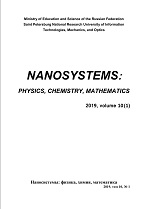|
Эта публикация цитируется в 2 научных статьях (всего в 2 статьях)
CHEMISTRY AND MATERIAL SCIENCE
Effect of ce cations on the crystallite size and pore structure genesis in nanostructured rutile after calcination
N. V. Shikinaa, E. V. Bessudnovaa, V. A. Ushakova, A. P. Nikitinb, M. S. Mel'gunova, A. V. Ishchenkoa, Z. R. Ismagilovba
a Boreskov Institute of Catalysis SB RAS, 5 Lavrentiev Ave., 630090, Novosibirsk, Russia
b Institute of Coal Chemistry and Materials Science, Federal Research Center of Coal and Coal Chemistry SB
RAS, 18 Sovetskiy pr., 650000, Kemerovo, Russia
Аннотация:
A method for the low-temperature synthesis of titania with the 3D rutile nanostructure was developed, and the effect of introduced cerium ions on the thermal stability of the material was studied. According to XRD, TEM, Raman spectroscopy and BET data, the introduction of 3–10 wt.% Ce into the rutile matrix decreases the growth of nanorutile crystallites under the action of high temperatures ranging from 300–1000$^\circ$ C and provides the formation of a more porous structure in comparison with unmodified samples. Cerium cations are stabilized in the region of interblock boundaries or in the structural defects of rutile TiO$_2$ and are released as the bulk CeO$_2$ phase only at 1000$^\circ$ C, which does not exert a stabilizing effect at this temperature.
Ключевые слова:
titanium dioxide, nanostructured rutile, hierarchical architecture, porous structure, thermal treatment.
Поступила в редакцию: 31.05.2018
Исправленный вариант: 03.08.2018
Образец цитирования:
N. V. Shikina, E. V. Bessudnova, V. A. Ushakov, A. P. Nikitin, M. S. Mel'gunov, A. V. Ishchenko, Z. R. Ismagilov, “Effect of ce cations on the crystallite size and pore structure genesis in nanostructured rutile after calcination”, Наносистемы: физика, химия, математика, 9:5 (2018), 688–695
Образцы ссылок на эту страницу:
https://www.mathnet.ru/rus/nano358 https://www.mathnet.ru/rus/nano/v9/i5/p688
|

| Статистика просмотров: |
| Страница аннотации: | 90 | | PDF полного текста: | 22 |
|




 Обратная связь:
Обратная связь: Пользовательское соглашение
Пользовательское соглашение
 Регистрация посетителей портала
Регистрация посетителей портала Логотипы
Логотипы







 Цитирование в формате
Цитирование в формате 
